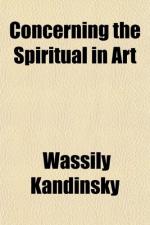We may go as far as the artist is able to carry his emotion, and once more we see how immense is the need for true emotion. A few examples will make the meaning of this clearer.
A warm red tone will materially alter in inner value when it is no longer considered as an isolated colour, as something abstract, but is applied as an element of some other object, and combined with natural form. The variety of natural forms will create a variety of spiritual values, all of which will harmonize with that of the original isolated red. Suppose we combine red with sky, flowers, a garment, a face, a horse, a tree.
A red sky suggests to us sunset, or fire, and has a consequent effect upon us—either of splendour or menace. Much depends now on the way in which other objects are treated in connection with this red sky. If the treatment is faithful to nature, but all the same harmonious, the “naturalistic” appeal of the sky is strengthened. If, however, the other objects are treated in a way which is more abstract, they tend to lessen, if not to destroy, the naturalistic appeal of the sky. Much the same applies to the use of red in a human face. In this case red can be employed to emphasize the passionate or other characteristics of the model, with a force that only an extremely abstract treatment of the rest of the picture can subdue.
A red garment is quite a different matter; for it can in reality be of any colour. Red will, however, be found best to supply the needs of pure artistry, for here alone can it be used without any association with material aims. The artist has to consider not only the value of the red cloak by itself, but also its value in connection with the figure wearing it, and further the relation of the figure to the whole picture. Suppose the picture to be a sad one, and the red-cloaked figure to be the central point on which the sadness is concentrated—either from its central position, or features, attitude, colour, or what not. The red will provide an acute discord of feeling, which will emphasize the gloom of the picture. The use of a colour, in itself sad, would weaken the effect of the dramatic whole. [Footnote: Once more it is wise to emphasize the necessary inadequacy of these examples. Rules cannot be laid down, the variations are so endless. A single line can alter the whole composition of a picture.] This is the principle of antithesis already defined. Red by itself cannot have a sad effect on the spectator, and its inclusion in a sad picture will, if properly handled, provide the dramatic element. [Footnote: The use of terms like “sad” and “joyful” are only clumsy equivalents for the delicate spiritual vibrations of the new harmony. They must be read as necessarily inadequate.]
Yet again is the case of a red tree different. The fundamental value of red remains, as in every case. But the association of “autumn” creeps in.
The colour combines easily with this association, and there is no dramatic clash as in the case of the red cloak.




